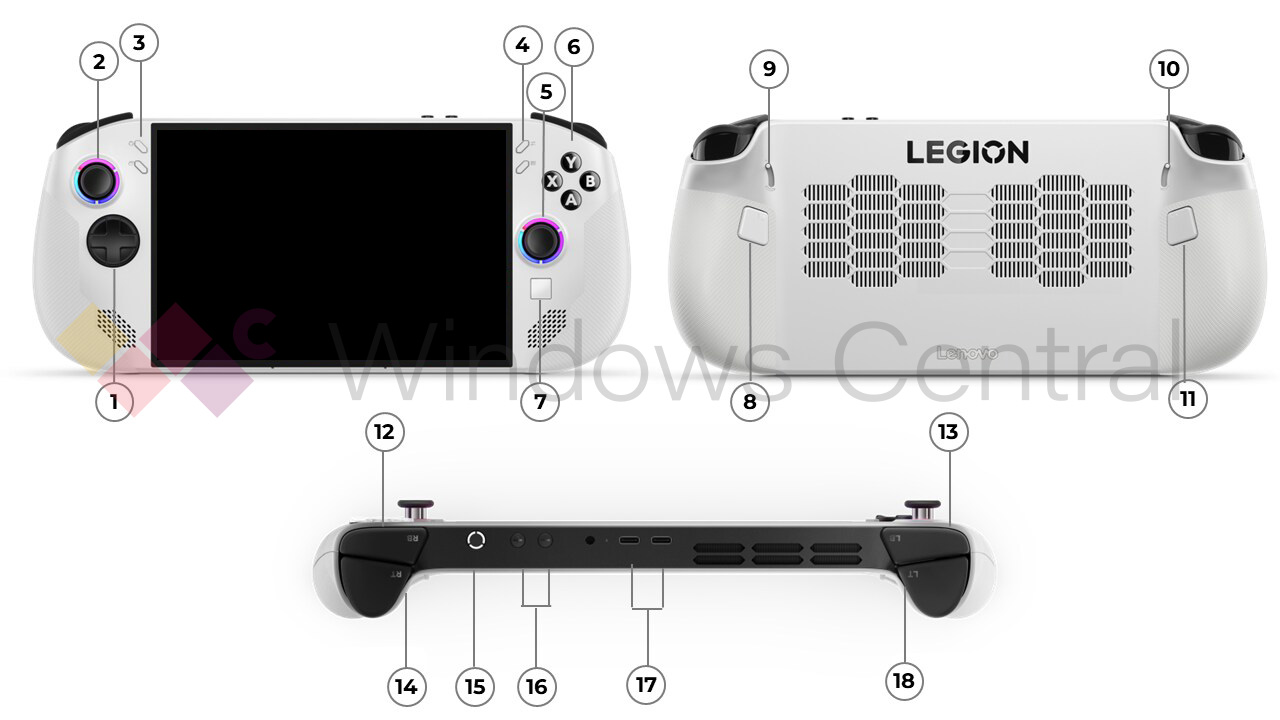
We've heard talk of new Lenovo Legion Go handhelds for a few months, but until now we'd had nothing official—just the odd rumour or unofficial picture of what looked like a new white chassis. Now, however, we have what looks like official pictures of a new Legion Go S, and we can tell quite a lot from them.
These renders come from Windows Central, which calls them "official" and says they were "shared and confirmed as genuine by our amazing and awesome sources". And they do indeed look like the real deal. Judging from these renders, the previous unofficial shell pictures seem to have been legit, as the new Legion Go looks to have an all-white casing and a design that takes somewhat after the Asus ROG Ally.
The most prominent changes, apart from the white body, seem to be the following:
- Non-detachable controllers
- Menu and View buttons moved to the top-right
- A nub in lieu of a trackpad
- One back-paddle on each side
- Both USB Type-C ports located on top
- Front-facing speakers
- No rear kickstand
One of the first things I noticed was that the design, following the ROG Ally, features noticeably shallower and presumably more comfortable controller grips. It's difficult to achieve that with detachable controllers like on the first generation, but it makes sense that Lenovo would opt for a step in such a direction for comfort with a new version that has its controls firmly and permanently attached.
We can only assume that the new Legion Go S will also have a smaller and presumably lower-resolution screen, and will probably (read: hopefully) be lighter than the original one, too. Again, this would be more of a step in the direction of the ROG Ally: lighter and more affordable.
I've been using the original Lenovo Legion Go for quite a while and I can say that these changes, if they all bear out in reality, will make a substantial difference. Which isn't to say they'll make a substantial positive difference, mind you. The moved buttons, front-facing speakers, curvier controller design, and possible lighter weight will all be very nice indeed. But as for the lack of detachable controllers and kickstand, I'm not so sure.

One of the main things I love about the Legion Go—and the main thing that keeps it afloat in what's becoming a saturated handheld market, IMO—is that you don't have to use it just as a handheld. Its biggest draw is its versatility, primarily because you can flip out the kickstand, sit it on the table or bed, pull off the controllers, and game from (slightly) afar. The big screen helps with that, too, of course.
The biggest gaming news, reviews and hardware deals
Keep up to date with the most important stories and the best deals, as picked by the PC Gamer team.
Get rid of that and what are you left with? Another handheld like the rest of them. Which is no bad thing in itself, of course. It's just important to note that Lenovo seems to be ditching the jack-of-all-trades idea and stepping more decidedly into the mainstream handheld market.

Best handheld gaming PC: What's the best travel buddy?
Steam Deck OLED review: Our verdict on Valve's handheld.
Best Steam Deck accessories: Get decked out.
Steam Deck battery life: What's the real battery life?
I suppose the question then, just as with the other big handheld players, will be how well it follows through on this. Much will clearly hinge on pricing and the competition's been heating up in the affordable segment that it seems the Legion Go S will be aimed at. The ROG Ally is currently going for $484 at Amazon, and if you're going for super-cheap, the Steam Deck's only $399 right now.
Plus, there are other Legion Go models that it might have to compete with, too. There's the original, of course, but there are rumoured to be two other new ones coming up, in addition to this S version.
While the S variant is rumoured to sport a Rembrandt processor, the spate of upcoming Legion Go handhelds are purported to sample the entire generational mix of AMD Z2 processors. We're expecting a Hawk Point one (previous-gen like the original Legion Go), a Strix Point one (current-gen), and a Rembrandt one (two gens old). From a performance perspective, it's obviously a Strix Point one that we'd be most interested in.
I could continue speculating until the calendar flips and summer rolls around, but we'll just have to wait and see. For now, though, it looks like "mainstream" and "affordable" is the direction Lenovo's leaning towards.

Jacob got his hands on a gaming PC for the first time when he was about 12 years old. He swiftly realised the local PC repair store had ripped him off with his build and vowed never to let another soul build his rig again. With this vow, Jacob the hardware junkie was born. Since then, Jacob's led a double-life as part-hardware geek, part-philosophy nerd, first working as a Hardware Writer for PCGamesN in 2020, then working towards a PhD in Philosophy for a few years (result pending a patiently awaited viva exam) while freelancing on the side for sites such as TechRadar, Pocket-lint, and yours truly, PC Gamer. Eventually, he gave up the ruthless mercenary life to join the world's #1 PC Gaming site full-time. It's definitely not an ego thing, he assures us.

